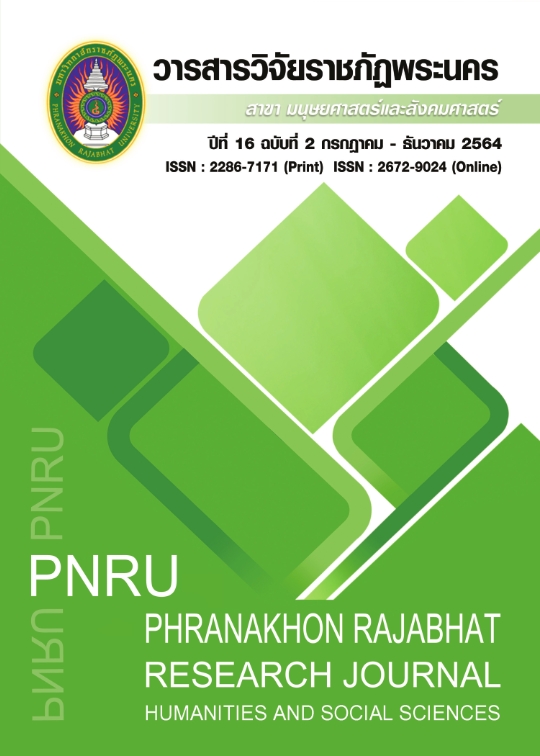SPATIAL STRATEGY FOR FOREST BURNING HANDLING IN SHAN STATE AND ITS EFFECTS ON COUNTRIES IN THE UPPER MEKHONG REGION
Main Article Content
Abstract
The objectives of this study were to investigate the problems of forest fire spatial management in Shan State affecting countries in the Upper Mekong Sub-region, to develop forest fire spatial management strategies in Shan State, and to evaluate the appropriateness of forest fire spatial management strategies affecting countries in the Upper Mekong Sub-region. This mixed-method research implemented a workshop, a context evaluation form, and an appropriateness evaluation form. The target group recruited 25 participants, including forest fire management leaders in Shan State and Shan State Army (SSA) officers in charge of the mountain areas of Southern Shan State. The data was analyzed by content analysis, mean and standard deviation. The circumstances of forest fire spatial management in Shan State affecting countries in the Upper Mekong Sub-region were reported. Strengths: The leader is a visionary. Weaknesses: Lack of a forest fire database due to deficiency of knowledge and tools in defining the forest boundary. Opportunities: Technological advancement enables global communication and attracts attention from neighboring countries, resulting in consistent assistance in forest fire management. Threats: Policy does not support decentralization and accessibility to management and utilization of natural resources. The formulated vision was “Shan State: Tranquil, Peaceful, No Wildfire Through Participatory and Sustainable Forest Management”. There were 4 developed strategies. Strategy 1: Develop cooperation and an integrated network with neighboring countries. Strategy 2: Develop a forest fire management system using appropriate information technology. Strategy 3: Develop the potentials of Shan people on sustainable forest management. Strategy 4: Allocate budget support and funds for the sustainability of forest management and forest fire prevention. The appropriateness evaluation of spatial strategy for forest burning handling in Shan State affecting countries in the Upper Mekong Sub-region in regard to vision, goals, strategies, and development guidelines showed the highest level of appropriateness.
Article Details
Each publish articles were copyright by Phranakorn Rajabhat University
Any contents which appeared in each articles in the journal were authors personal opinion. It did not relate to Phranakorn Rajabhat University and other instructors in the university. Each authors would take responsibility on their articles. If there are any mistake, the authors will take responsibility themselves
References
Jarungrattanapong, R. & Manasboonphempool, A. (2009). Effects of haze on tourism: the case of Chiang Mai and Phuket. Chiangmai: Public Policy Studies Institute Foundation. (in Thai)
Kochakote, Y. (2010). Development of forest fire prevention models. Ph.D. Program in Environmental Education. Mahasarakham: Mahasarakham University. (in Thai)
Kreasuwun, J., Chodamornsuk, C., Wirunvedchayan, O. & Ratjiranukool, P. (2008). Weather analysis and air pollution warning. Bangkok: Thailand Science Research and Innovation. (in Thai)
Larpjit, S. (2009). Factors Affacting Citizen’s Decision to Participation in Tambol AdministrationOrganizations in Warinchamrab District, Ubonratchathani Province. Veridian E-Journal. 2(1), 137-154. (in Thai)
Rattanawipa, P. (2004). The Participation of the communities in protecting and solving problems of air pollution in the Chiang Mai Municipality. Chiang Mai: Graduate School, Chiang Mai University. (in Thai)
Rayanakorn, M. (2010). Haze and Air Pollution in Chiang Mai. Bangkok: Thai Health Promotion Foundation. (in Thai)
Sopitcha, T. (2010). Guidelines for forest fire prevention in vulnerable areas in the Lower Mekong Basin. Ph.D. Program in Regional Development Strategies. Ubon Ratchathani: Ubon Ratchathani Rajabhat University. (in Thai)
Wongsankhum, R. (2007). Air pollution management of stakeholders in Mueang district, Chiang Mai province. Chiang Mai: Graduate School, Chiang Mai University. (in Thai)


